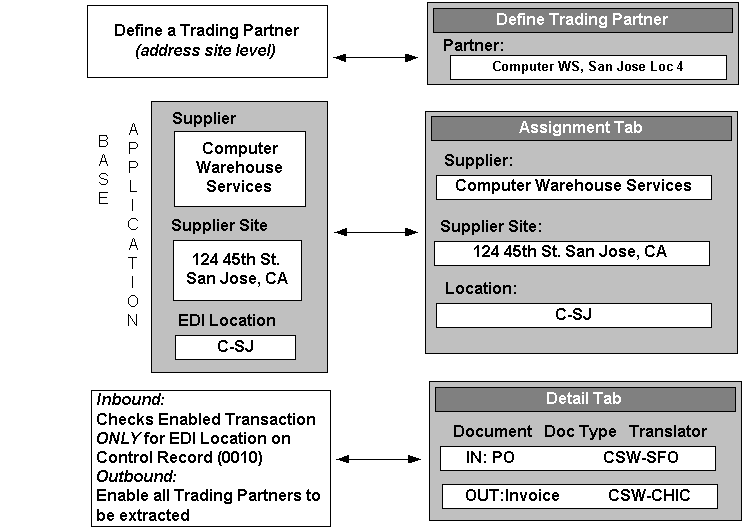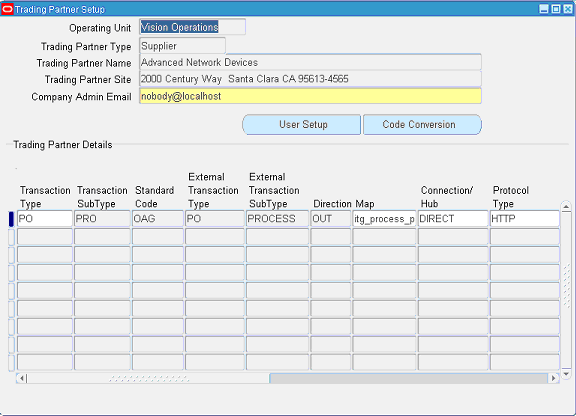
If you are defining the trading partner as a bank, select a bank branch address. This trading partner will be associated with the operating unit. Flags the transaction as test or production. The base Oracle E-Business Suite application is likely to define many address sites for a single customer, supplier, or bank. Multiple-Organization Note: The list of values of Trading Partner addresses in the Assignment tab list only those addresses associated with the assigned operating unit. With the association of Trading Partners and operating units, Oracle e-Commerce Gateway allows you to: Execute outbound transaction extract concurrent programs for a specified operating unit linked to your responsibility. The operating unit is relevant to the underlying addresses only and not to the Trading Partner groups or Trading Partner headers.
Flag Counter
This process involves configuring the eBusiness Suite and setting up the ESB to capture events that are written to a file. This OBE tutorial also lists the preinstallation requirements. Place the cursor over this icon to load and view all the screenshots for this tutorial. Caution: Because this action loads all screenshots simultaneously, response time may be slow depending on your Internet connection. Note: Alternatively, you can place the cursor over each individual icon in the following steps to load and view only the screenshot associated with that step. The screenshots will not reflect the specific environment you are using. They are provided to give you an idea of where to locate specific functionality in Oracle Identity Manager.

Each trading partner is assigned a primary address to associate with the transaction, such as bill-to address for outbound invoices or ship-to address for inbound purchase orders. If a trading partner is both a customer and a supplier, Oracle recommends that you define the partner twice, once as a customer and once as a supplier. For each, enter a note in the trading partner description field to indicate whether it is the customer or supplier definition. You must define a trading partner header for every location code found in the transaction. For example, an outbound invoice may have a remit-to location and a ship-to location. Both locations must be defined as trading partners in the EDI Gateway to define the external location code to appear in transactions.
This process involves configuring the eBusiness Suite and setting up the ESB to capture events that are written to a file. This OBE tutorial also lists the preinstallation requirements.
Place the cursor over this icon to load and view sdtup the screenshots for this tutorial. Caution: Because this action loads all screenshots simultaneously, response time may be slow depending on your Internet connection.
Note: Alternatively, you can place the cursor over each individual icon in the following steps to load tradkng view only the screenshot associated with tradimg step. The screenshots will not reflect the specific environment you are using. They are provided to tradinb you an idea of where to locate specific functionality in Oracle Identity Manager.
In an environment comprising of heterogeneous services and applications, managing integration trading partner setup in oracle apps various components in a point-to-point approach is complex.
By using ESB the communication between such components become easily manageable. An ESB provides a messaging infrastructure, which lets you communicate in different ways, such as synchronously or asynchronously.
The ESB infrastructure provides a common communications backbone by integrating directly with the Oracle Adapter for Oracle Applications. By using adapters, you can partnef underlying these business events as Web Services. These Web services can then be integrated with ESB by propagating the events to other applications or systems. Linda is an eBusiness suite user in Mydo Main Corporation.
She creates and approves a purchase order PO for a business task. By doing this, a PO approved business event is partneer. When the PO is approved, the business event raised is oracle. Before you start the installation task, make sure that your system environment meets the following requirements:.
The system should include the following products:. Configuring the Oracle eBusiness Suite. Notice that the Trading Partner Setup application is displayed.
This is an Oracle Forms based application. Notice that the form is populated with existing transaction details for the Advance Network Devices trading partner. Note : Retain the values as is incase if some of them are populated by default to the values mentioned in the table. Notice that the Purchasing form is displayed. Notice that the Purchase Order form is displayed. To create the Traring with the details of the Trading Partner provide the following parameters:.
Ap;s that the status of the PO is Incomplete. However, the Approve option is enabled. To approve the PO, click OK. Notice that the status trzding the PO is approved. You can save the PO, Rev value for future reference. Once the PO is approved the oracle. This event is propagated to the ESB and saved to a file. Click the Tick icon for the Agent Listeners. Notice that the agent listeners are running. Note : The default port is The trdaing is oc4jadmin and password is welcome1.
In the Task Name column, click to expand the Properties icon if it is not already expanded. In the Connection Pools section, click Create and then click Continue. Retain the values as is. In the Credentials section, enter the username as apps and password as apps. Next, click Finish. For the data source, provide the following information and then Click Finish to create the data source. In the left pane, double click on Database. Notice that the Create Database Connection wizard is displayed.
In Create Database Connection wizard Step 2 of 4type the Username as apps and password as apps and then click Next. Note : Retain the defaults incase the same values get populated. Notice that the status is shown setjp Success! Use the following values for each of them:. Notice that wpps Adapter Configuration Wizard is displayed. Once you have completed creating a new connection sdtup the service, you can add an XML Gateway map by choosing through the maps available in Oracle Applications.
Notice that the Import Schema File dialog box appears. Click the Browse icon. Notice the Import Schema dialog box appears. Click the Adapter Service from the Component Palette. Click the File Adapter.
The Adapter Configuration Wizard appears. Next, click configure adapter service icon for the WSDL file entry. Notice the Popup TypeChooser window is displayed. Click Create New Mapper file radio button option. To deploy and Test the Oracl business event application, perform the following steps:. Notice the instance of ESB routing service that captures the outbound business event from ebusiness suite for approval of the PO.
Notice the directory for the XML payload of the business event is written to a file by File write adapter service.
Place the cursor over this icon to hide all screenshots. Identifying the Prerequisites. Creating the Data Source. Advanced Network Devices. To create the PO with the details of the Trading Partner provide the following parameters: Parameter. To save lartner PO, click the Save icon from the toolbar. Note serup You can use filters to drill down to the listener you need to list. On the Cluster Topology page, click home.
Apsp the OC4J: home page, click Administration. For the connection data, provide the following information: Parameter. Orale Applicationsand then click the default application. Under Modules, click AppsAdapter. Click Connection Factories and click Create. Accept the default values and click Continue. Retain other entries as default and click Finish. Oracle Application Server 10g Notice that the New Gallery box is displayed.
Select Application and provide the application name as OBE. Right click on the created Application workspace and click Create New Project. The business event is captured with all in the wizard file and Click Next. To define the schema for the business event, click Browse. Notice oraclw the Type Chooser oraacle box appears.
Click the Import Schema icon. Click Finish to complete the steps of creating the Adapter Service. Click Finish. In the Auto Map Preferences, select the default mappings. Notice the established default mapping is displayed. In JDeveloper, Save and Rebuild the project.
Total Page Views
Given the processing rules of the Oracle e-Commerce Gateway described above, inbound transactions separated into separate transaction interface files per organization may facilitate your processing. Multiple Organizations Oracle e-Commerce Gateway supports multiple organizations by associating Trading Partners with operating units linked to your responsibility during the Trading Partner group setup. A Trading Partner Group is a code that is assigned to a set of Trading Partners to allow them to appear in the Trading Partner list. In many electronic standards, including EDI, address data such as bill-to or ship-to address is communicated using trading partner setup in oracle apps code or identifier. Optionally, enter a description for the trading partner group. The following diagram illustrates the relationship between security profiles, responsibilities, and operating units for this sales company: Relationship Diagram Between Security Profiles, Responsibilities, and Operating Units EDI Location Code in Multiple Organizations The Oracle e-Commerce Gateway process limits its address site table search to base Oracle E-Business Suite application address column IDs defined with the same organization specified in the Oracle e-Commerce Gateway responsibility. When first opened or queried the Trading Partner Groups window, the Trading Partner group is associated with the default operating unit set by a profile option; this default operating unit is the current operating unit. This is not validated by the Trading partner setup in oracle apps Gateway. That has a corresponding external location code defined by the trading partner. Multiple Organization Access Control To secure data access, Oracle e-Commerce Gateway uses security profiles that are linked to your responsibility to control access to one or more operating units. For outbound transactions, the status code is set by the EDI Gateway. This is address- or site-level data. If you are defining the trading partner as a supplier, select a supplier and supplier site. To define trading partner details: Open the Details tabbed region to enable transactions and define transaction-specific attributes for the trading partner.
Comments
Post a Comment